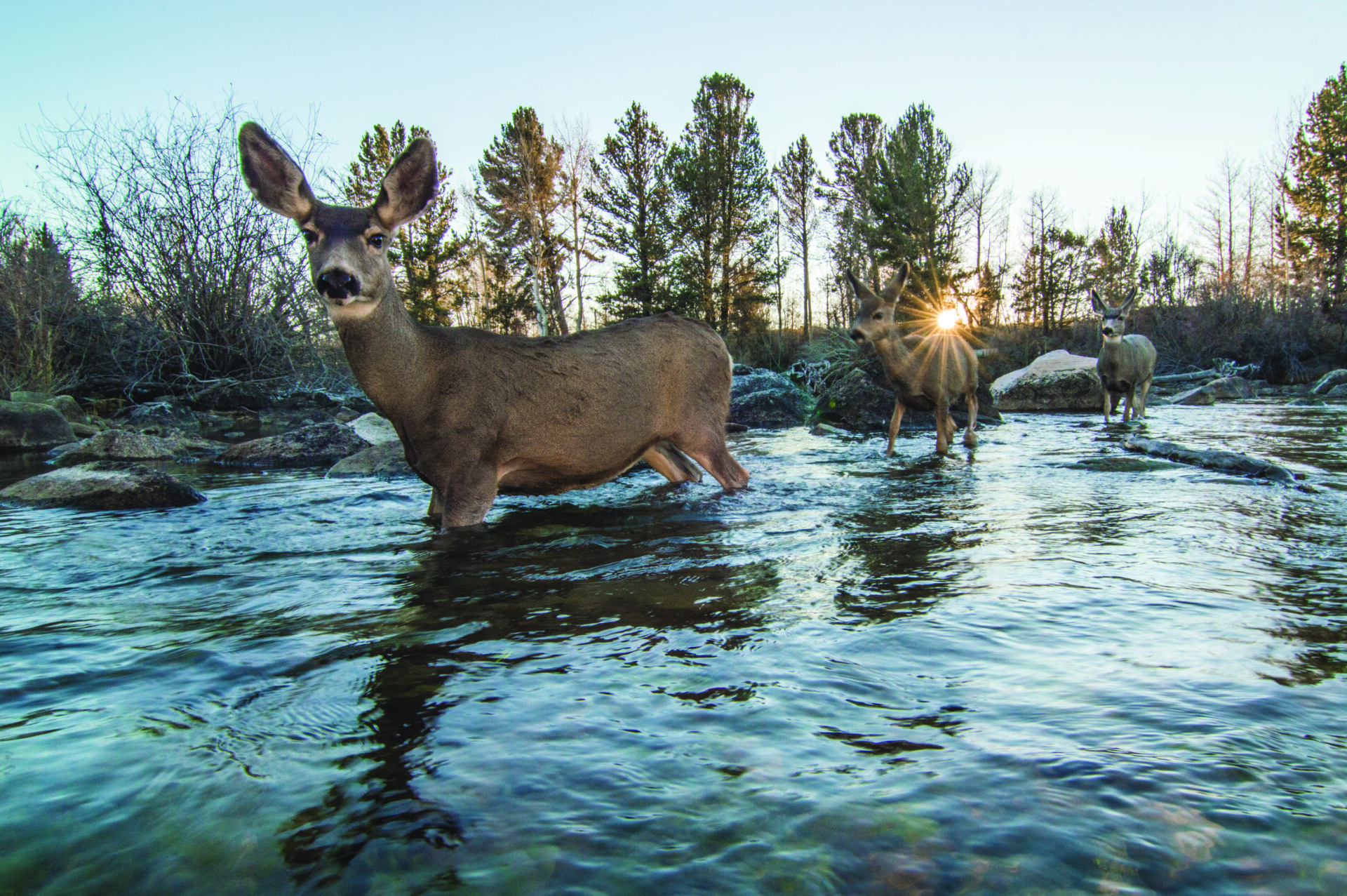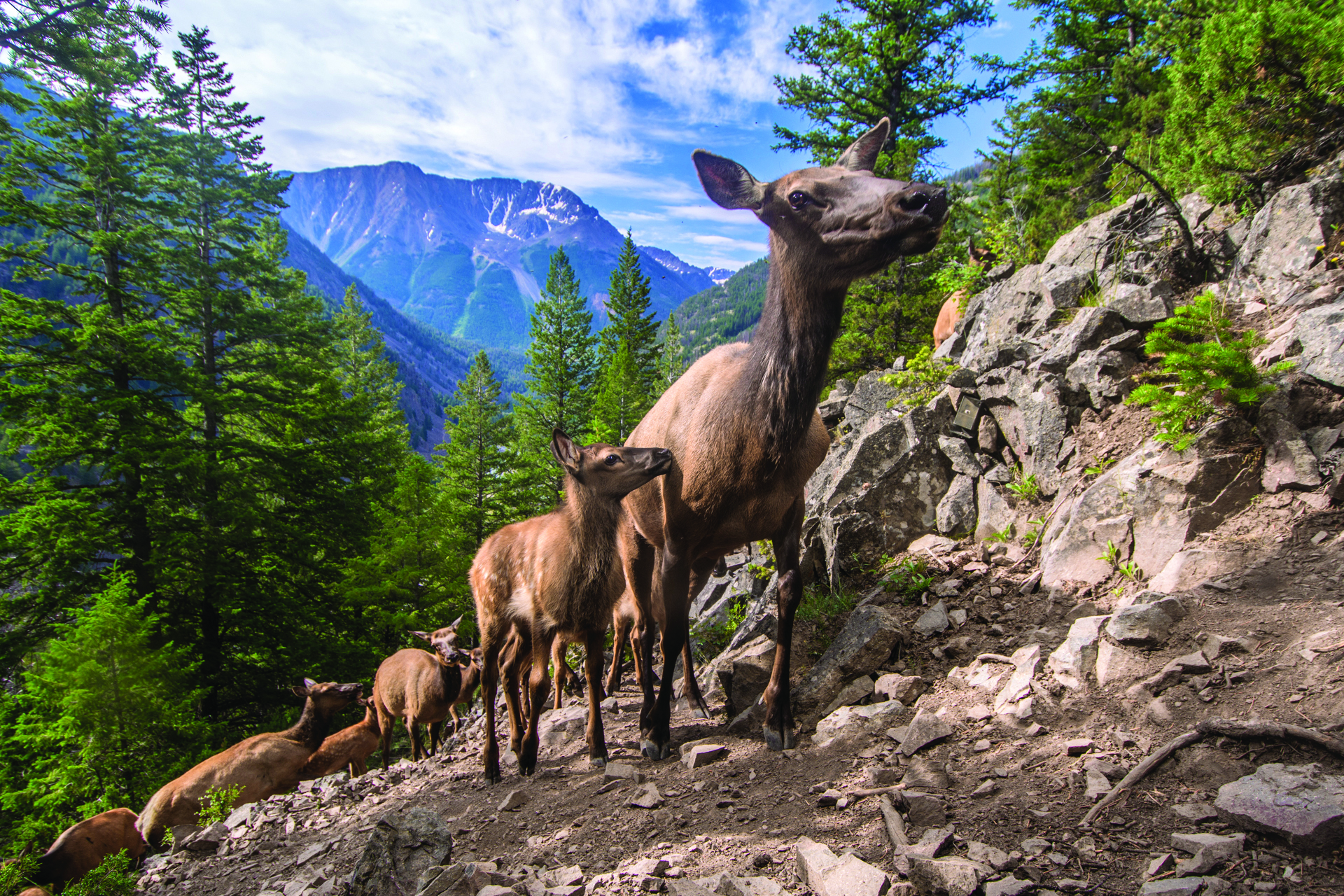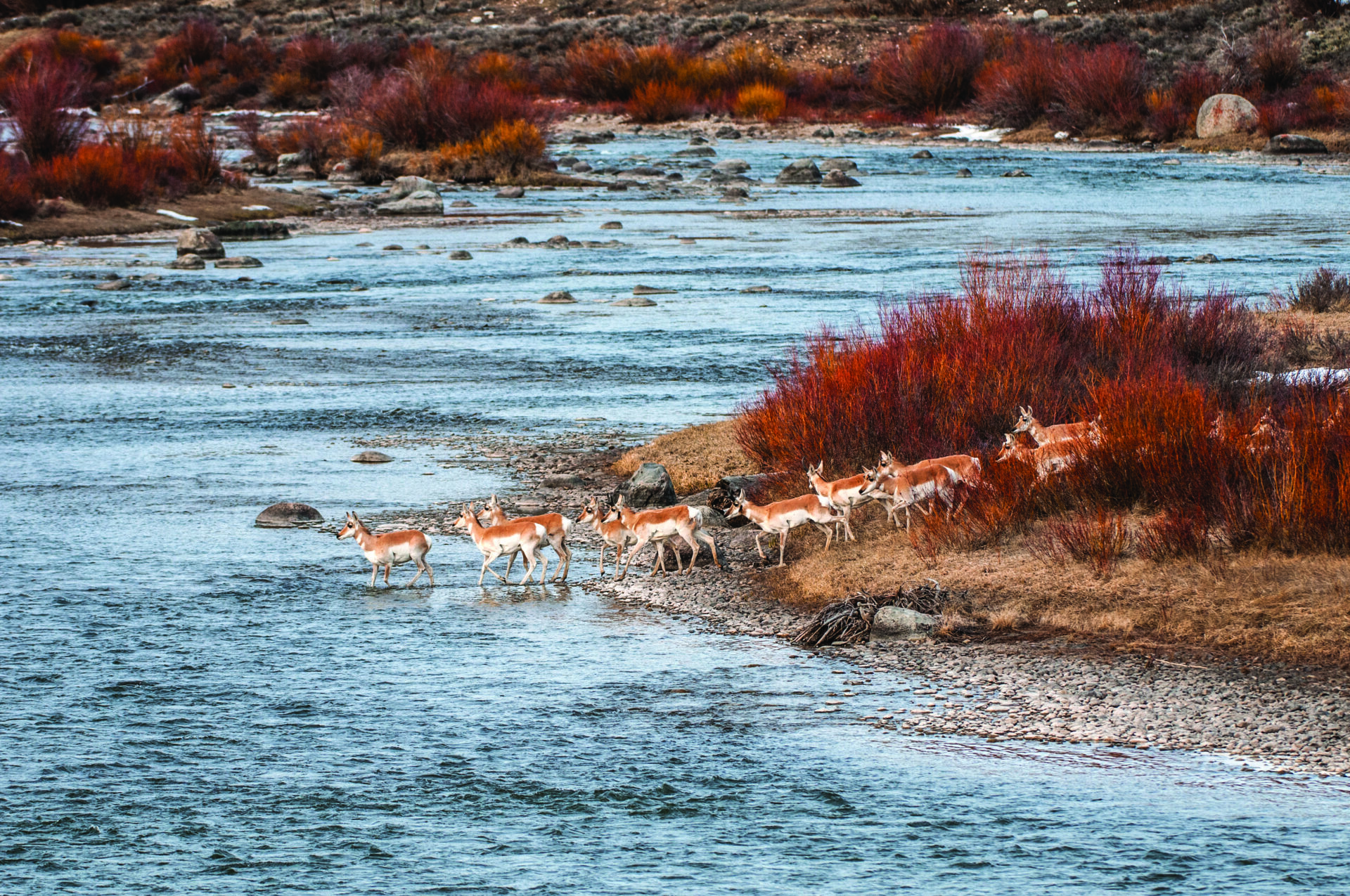Read The
Current Issue
Here, there, in between:
The marvel of the Greater Yellowstone Ecosystem’s migrations
The network of migratory wildlife that pulses in and out of the Greater Yellowstone Ecosystem’s core is one of the ecological phenomenon prized not just within the United States, but the entire world. And there’s a unique opportunity to save the whole system.
// By Mike Koshmrl //photography by joe riis

One decade ago, Grand Teton National Park biologists set out to learn where the mule deer that live in the park in the summer came from and what route they took to the Tetons.
There were some assumptions going into this 2013 effort to dart, capture, and collar dozens of doe deer in places like Jenny Lake, Colter Bay, Flagg Ranch, and Moose. Some of the animals likely came from eastern Idaho, past research had suggested. But other than that, there was little indication of where the Tetons’ summering deer spent their winters. Their paths to get there—i.e., their migration routes—were equally unknown. That fall and winter, when location results started trickling back from the deer’s GPS collars, biologists were struck with awe. Three previously unknown migration paths shot off to the east, tying the Tetons to places like the Absaroka Front and the Wind River Indian Reservation. Other deer trekked south, headed down the Green River Basin toward Rock Springs. The suspected westward travelers materialized too—deer bound for the Teton River corridor and Idaho’s Sand Creek Desert. Yet other park deer completed shorter seasonal journeys within Jackson Hole, headed for places like East Gros Ventre Butte and Cache Creek.
“These results were just simply incredible,” Teton Park wildlife biologist Sarah Dewey told an audience in 2021. “What these deer ended up doing just blew us away. It wasn’t just a single migration corridor. It turned out to be a whole network.”
If there’s anything unsurprising about the miraculous migratory melting pot of mule deer discovered in Grand Teton National Park a decade ago, it’s that they dwell in the Greater Yellowstone Ecosystem. It’s an intact, interconnected roughly 22-million-acre ecological complex that spans three states, 17 counties, and myriad land jurisdictions—and it’s absolutely teeming with migratory wildlife, including bison, moose, elk, mule deer, and pronghorn antelope. Superlatives are appropriate when describing the tens of thousands of ungulates flowing like a two-way river to and from the ecosystem’s high country to lower-elevation deserts and grasslands. “As we are getting a clearer picture of migrations around the world, we’re learning that the Greater Yellowstone is really this unique migratory landscape,” says Matt Kauffman, a University of Wyoming professor who leads the Wyoming Migration Initiative. The special stature of migration in the ecosystem isn’t limited to the ecological phenomenon, he says. “In some ways, what’s more exciting to me is that the opportunities to conserve the migrations of the Greater Yellowstone area are really unparalleled on a global scale.”
“As we are getting a clearer picture of migrations around the world, we’re learning that the Greater Yellowstone is really this unique migratory landscape.”
—Matt Kauffman, leader of the Wyoming Migration Initiative
Migration policy and conservation are being pioneered in the region and in Wyoming. Jackson Hole’s 400 or so pronghorn pass through the first federally protected migration corridor in the United States, a route through the Gros Ventre and Upper Green River drainages known as the Path of the Pronghorn (see sidebar, page 116). It was designated by the Bridger-Teton National Forest in 2008, though southern reaches on Bureau of Land Management property still haven’t been protected 15 years later due, in part, to political pressure to not impose restrictions on valuable natural gas fields. A decade later the state of Wyoming followed federal land managers’ lead, designating the Red Desert-to-Hoback migration corridor—traveled by some of Dewey’s tracked deer—and two other mule deer migration routes via an executive order signed by Gov. Mark Gordon. “It is one of the first forays into the conservation of wildlife migration corridors,” says Matt Skroch, who directs a migration-focused program for the Pew Charitable Trusts. “After several years, despite having some challenges in implementation, it remains one of the most robust actions by a governor in a Western state to conserve wildlife migration.”

There wouldn’t be such a robust effort to protect migrations if they were already gone. In much of the world and the American West, they’ve been wiped off the map. There’s a whole book about the largely human-caused collapse: David Wilcove’s No Way Home: The decline of the world’s great animal migrations. What makes the Yellowstone region buck the trend?
One theory is that the ecosystem is a hotspot for migration partly due to another hotspot, this one geologic. A magma chamber pressing up against the earth’s surface has elevated the Yellowstone plateau in the center of the ecosystem to roughly 8,000 feet above sea level. Atop the plateau is a verdant landscape with plenty of groceries for hooved mammals in the summer and fall, but it’s not especially habitable for most species come winter, when down comes a few hundred inches of snow. “All the good winter ranges are away from the heart, down on the private lands and the BLM lands in the three different states,” Kauffman says. “So there was lots of migration originally.”
Joel Berger, a senior scientist with the Wildlife Conservation Society, is a former denizen of Jackson Hole who helped pin down the Path of the Pronghorn while the route was still being mapped out two decades ago. Today, he teaches at Colorado State University in Fort Collins, Colorado, along the northern reaches of a five-million-person metropolitan complex that stretches from Colorado Springs to the Wyoming state line. In populated places like Colorado’s Front Range, he says, most mammals abandoned long-distance movements long ago. “It is so far gone,” Berger says. “We get a little bit of bighorn sheep movement, we get mule deer movement. So there’s a little bit, but we probably retained 1 percent of what we used to have—maybe less.”

Not so in the Yellowstone Ecosystem. Although it’s a fast-growing region, especially on the Wyoming side it’s still pretty wild. “There’s just not that many people,” Kauffman says. “There’s Jackson and Cody, of course, but as you spill outward, all of the other towns are quite small. The migrations skirt around Dubois. They kind of move around Alpine, around Pinedale.” And the ungulate paths that ebb and flow around the landscape have been relatively well studied, thanks to the national parks and attention paid by Kauffman’s Wyoming Migration Initiative, the Wyoming Game and Fish Department, and other research outfits. Maps have been assembled illustrating 10 elk herds that head for the Yellowstone high country each summer. A gaping hole on the map once centered along the west slope of the Tetons, but it was filled in by a 2019 research project to map the travels of the Targhee Elk Herd.
University of California professor Arthur Middleton, who assisted that research, likes to describe the Greater Yellowstone Ecosystem’s elk as one giant super herd. Following the nutritious green-up of vegetation that moves steadily uphill as spring and summer unfold, the tens of thousands of animals on the move are part of what makes the Greater Yellowstone Ecosystem unique. “One of the handful of absolutely fundamental natural features of the GYE that jumps out at me is the migratory nature of the system,” Middleton says. “It’s the diversity and abundance of these migratory herds. There’s also consistency in the movements up to the high country in the core areas of the system, and consistency in the movements back down. It’s about May 11 [they go up] and November 20 [they come down]. There’s a lot of variability by herd and by individual, but there’s this broad, common movement around the ecosystem that occurs.”
It’s not just elk. The U.S. Geological Survey has published several sets of migration maps over the last few years showing where hoofed mammal herds migrate in the western United States. Within that map collection, there are 40 mapped migrations in Wyoming. Those maps are detailed with data describing the many migration routes that pulse tens of thousands of elk, deer, and pronghorn toward Yellowstone each spring. The 3,800 mule deer in Idaho’s Sand Creek Mule Deer Herd, for example, travel an average of 35 miles on their eastward trek toward the Yellowstone plateau, but as far as 75 miles. Their migration toward the Caribou-Targhee National Forest just outside of Yellowstone lasts for 33 days on the way uphill. They traverse a corridor that treads over 430 square miles of eastern Idaho and western Wyoming.
The USGS report goes beyond data, identifying conservation challenges. For the Sand Creek Herd, for example, there’s an “extensive network of fencing” and a heavy dose of roadkill from traffic on U.S. Highway 20. For almost every herd on the go, there are challenges. Chip Jenkins, who took the helm at Grand Teton National Park seven years after Dewey’s deer discovery, knows he has to look well outside the borders of his 310,000-acre park to do his job correctly. “Grand Teton National Park is big, but the needs of wildlife are bigger,” he says. “Whether you’re talking about ungulates or you’re talking about large carnivores, these species need to move about on the landscape in order to meet their needs.” Even the most celebrated migrations face challenges.

The Red Desert-to-Hoback migration—the longest known deer migration in the world, at up to 242 miles one-way—is a good example of an embattled corridor. For the online nonprofit news site WyoFile, where I’m a staff writer, I reported last fall that a series of private land developments are on the path to breaking ground within the herd’s migration corridor, including a subdivision, grocery store-sized therapy center, and a luxury resort being built by TD Ameritrade’s billionaire founder Joe Ricketts. Although Gov. Mark Gordon’s migration policy has been held up as a national gold standard, those types of encroachments expose shortcomings—the state’s designation provides no protection on private land. That leaves effective migration conservation up to landowners. Berger, for one, isn’t confident that the free market will leave room for the deer in the long run. “We continue to dice and slice land,” he says. “If we wait for volunteerism, the message is clear: it hasn’t worked very effectively in the past. Protecting migration is a complicated matter. We need to do better.”
Following Wyoming’s lead, the federal government has put the spotlight on migration and freed up some money to help conserve this awe-inspiring biological phenomenon. Former U.S. Department of the Interior Secretary Ryan Zinke took a step in that direction in 2018, signing a secretarial order to improve big game migration corridor habitat in national parks and BLM property in 11 Western states. The U.S. Department of Agriculture, which has oversight over national forests, has also funded incentive programs to preserve migration on private land via perpetual conservation easements and through other means. The Absaroka Front—where some GTNP deer spend their winter—has been identified as a priority area where landowners are eligible for a $16 million initial infusion of USDA funding. Landowners with property in the Red Desert-to-Hoback migration corridor are equally eligible.
Middleton, a senior USDA advisor when he’s not teaching at UC-Berkeley, says that progress is being made, even if there’s a divergence of opinions about the correct way to conserve migration. “My eyes have been opened to how much public resources get spent on things like fence modification and removal, or cheat grass and weed management—things that really matter to the permeability and the quality of the habitat,” he says. “Let’s make sure that we know how to target those projects and be effective.” One way to keep doing that is to keep on with the science. A lot of the groundbreaking wildlife research that took root in the Greater Yellowstone Ecosystem has long been logged in the annals of history. Think Olaus Murie’s nearly century-old investigation of the Jackson Elk Herd’s ecology or Frank and John Craighhead’s seminal ecological study of grizzly bears in Yellowstone National Park. With migration, the findings are still unfurling in the modern era. There are still likely a couple dozen Wyoming migrations that are yet to be mapped, according to Kauffman.
That’s a reminder that the window is still largely wide open to map, designate, and preserve the Greater Yellowstone’s migration paths, whether through the force of policy or voluntary incentives for landowners. “As we look around the globe, it’s pretty sad,” Kauffman says. “A lot of the migrations that we’re looking at, we’re just watching them get cut up. Whereas in the Greater Yellowstone, there really is this tremendous opportunity to conserve the functionality of migration at the scale of an entire ecosystem.”






